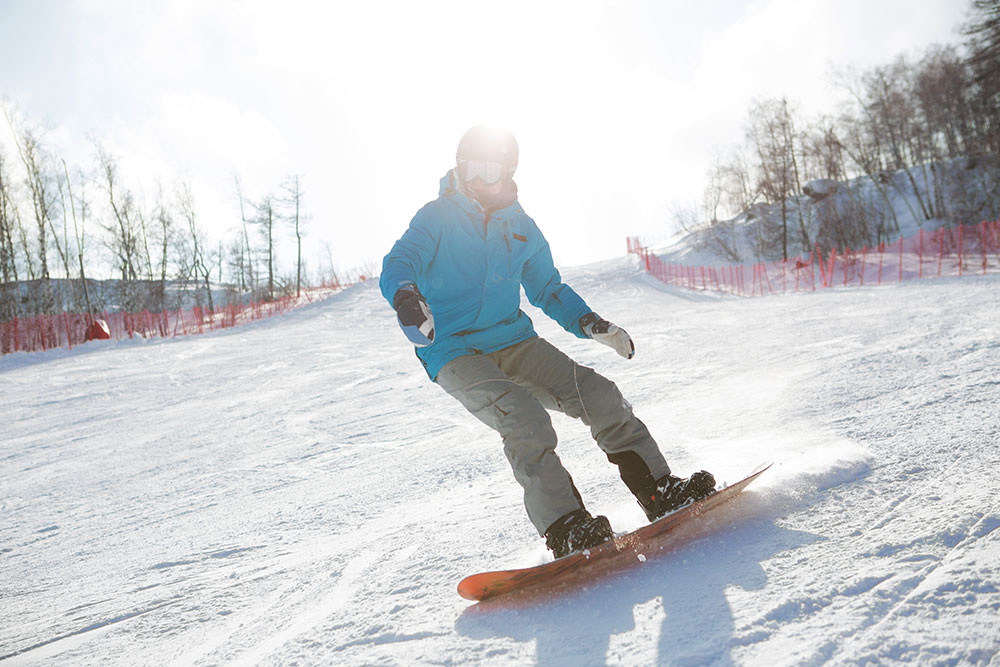
Common Snowboarding Injuries
Nearly 10 million snowboard athletes hit the slopes every winter. From beginners to pros, injuries occur. The most common snowboarding injuries are caused by an impact or fall. Frequently, injuries involve the:
- Knee
- Shoulder
- Wrist
- Head
Dr. Richard Cunningham is an expert at diagnosing and treating snowboarding injuries in athletes who have sustained an injury in Vail, Aspen, Steamboat, Summit County, or Denver, CO.
Knee Injuries Seen in Snowboarders
Knee injuries are most commonly seen in intermediate snowboarders. A common mechanism of injury involves a fall forward and impact to the lead-foot knee. This can cause ligament strains, tears, or fractures to the knee. The anterior cruciate ligament (ACL) and medial collateral ligaments (MCL) are most frequently involved, because these ligaments are subject to the greatest amount of force from forces transferred from the foot and ankle being secured in a snowboard binding. The more sudden and sharp the movement, the greater the likelihood of injury. In more severe cases, the ACL or MCL may completely tear. Knee fractures can also occur. MCL tears can heal well if a knee brace is applied soon after the injury. ACL tears and displaced fractures involving the knee joint require surgery.
Shoulder Injuries in Snowboarders
Shoulder and clavicle injuries happen more often in advanced snowboarders who are performing higher speed maneuvers. Any direct fall onto the shoulder complex may result in injury. The excessive force placed on the shoulder joint can cause several types of shoulder injury, including:
- Dislocation
- Separation
- Sprains and tears
- Fracture
Dislocation occurs when the force is great enough that the ligaments holding the head of the humerus in the socket (glenoid) are torn and the head is pushed out of the glenoid. Anterior dislocations are most common, where the head comes anterior or out the front of the glenoid. Less common are posterior or inferior dislocations. A first time dislocation is usually treated with physical therapy but repeated dislocations require arthroscopic surgery to repair the ligaments and stabilize the shoulder.
Shoulder separations involve the acromioclavicular (AC) joint. The AC joint is the joint on the top of the shoulder where the end of the clavicle (collarbone) meets the acromion (part of the scapula or shoulder blade). Typically, the AC joint is disrupted due to a direct fall on the tip of the shoulder. The ligaments holding the acromion and clavicle are torn to varying degrees. There are 6 types of AC joint separations, with type 1 being mild and type 6 being severe. Types 1 and 2 are treated without surgery. Types 4,5,6 and some type 3 separations due better if treated with surgery.
Finally, rotator cuff tears can occur as a result of falling while snowboarding. The rotator cuff is composed of 4 muscles and their associated tendons that power the shoulder. Rotator cuff tears can be partial or complete tears where the tendon pulls completely away from its bone attachment. Rotator cuff tears can involve 1 or up to all 4 of the tendons. Patients present with pain and weakness. Partial tears can be treated without surgery but full tears are best treated with arthroscopic repair.
Wrist Injuries in Snowboarders
Snowboard wrist injuries often occurs as a result of falling backward onto an outstretched hand. One of every five snowboard accidents is a wrist injury. A common fracture is what is called a distal radius and ulna fracture. In this injury, the ends of the two forearms bones are bent back so forcefully that they fracture and displace. Other common wrist injuries are ligament tears in the wrist or a fracture to a small but important bone in the wrist called the scaphoid. Ligament sprains can often be treated with a splint. Displaced fractures of the wrist or forearm require surgery.
Head Injuries in Snowboarders
Head injuries in snowboarders usually occur from falling backward and striking the back on one’s head. Often, athletes will experience only short term symptoms, such as a headache, with no further effect. However, if you experience a worsening headache, changes in vision, loss of memory, nausea or vomiting, or any loss of consciousness, then you should seek immediate medical attention. Wearing a helmet is critical to preventing a severe head injury.
How to Prevent Snowboarding Injuries
With all recreational and professional athletes, injury prevention is a priority. The critical prevention methods include:
- Strength and fitness training
- Proper gear selection and maintenance
- Heightened awareness of conditions during riding
A snowboarder’s fitness regime includes balance and core strengthening (focusing on the muscles that provide spine stability), leg strengthening to include hamstring, quads, glutes, hip flexors, as well as ankle plantarflexors and dorsiflexors. Aerobic conditioning is also important.
It’s important to have the proper gear and maintain your snowboard equipment. A properly fitting helmet can prevent serious injury to the head.
Finally, awareness of weather and snow conditions is important for preventing injury. Often people are injured when there is flat light and they are unable to adequately see natural hazards. Pay attention to fatigue, hydration and physical energy level. Stop when the body indicates. Following these common sense prevention steps will keep you healthy and on the board.
If you have sustained a snowboarding injury on the hill, contact Dr. Cunningham and his team to learn how he can help get you back to snowboarding: 970-569-3240.
